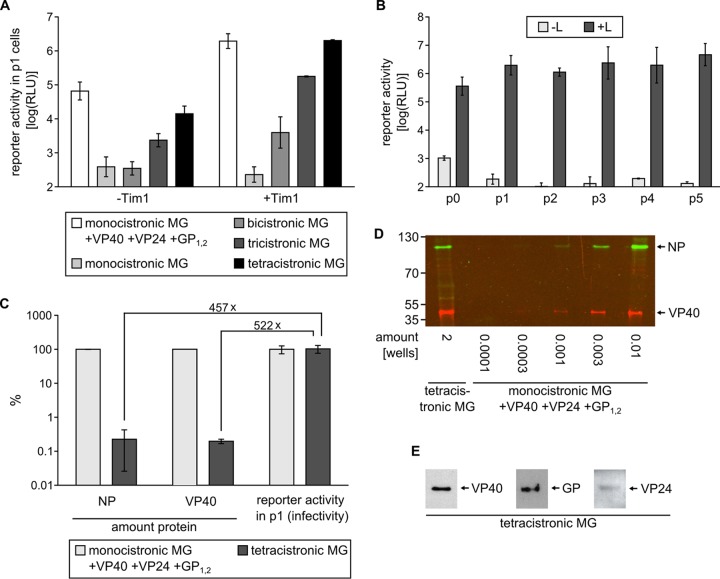FIG 3.
Characterization of trVLPs produced by multicistronic minigenomes. (A) Infection of target cells in the presence or absence of Tim1 with trVLPs produced using different multicistronic minigenomes. trVLPs containing different minigenomes (MGs) were produced and used to infect target cells that had been pretransfected to express the RNP proteins and either Tim1 or no Tim1. In the case of the monocistronic minigenomes, trVLP production was driven by expression of VP40, VP24, and GP1,2 from plasmids. Reporter activity in target cells was determined 72 h after infection. The means and standard deviations from 3 independent experiments are shown. (B) Continuous passaging of tetracistronic trVLPs. trVLP assays were performed with a tetracistronic minigenome in the presence or absence of the viral polymerase L. Supernatant from p1 target cells was passaged 72 h after infection of the p1 cells onto p2 target cells pretransfected with expression plasmids encoding the Ebola virus RNP proteins NP, VP35, VP30, and L, as well as Tim1. This infection was repeated every 72 h for a total of 5 passages. The means and standard deviations from 3 independent experiments are shown. (C) Relative infectivity and trVLP amounts produced by a tetracistronic minigenome. trVLPs were produced with VP40, VP24, and GP1,2 expressed either from expression plasmids (when using a monocistronic minigenome) or from a tetracistronic minigenome. trVLPs were then used to infect target cells in order to determine the total infectivity of the trVLP preparation, or they were purified through a sucrose cushion, followed by quantification of the VP40 and NP levels in the trVLP preparation (see also panel D). The levels of infectivity and the amounts of VP40 or NP in the trVLP preparation produced by a monocistronic minigenome and VP40, VP24, and GP1,2 from expression plasmids were defined as 100%. The means and standard deviations from 3 independent experiments are shown, and fold changes in the ratios of the protein amount to trVLP infectivity are indicated. (D) Quantification of protein content in trVLPs. trVLPs which had been purified as described in the legend to panel C were subjected to Western blotting using antibodies directed against VP40 and NP. In order to compensate for different trVLP concentrations, different amounts of trVLP preparations were loaded. The numbers of wells (or the fraction of a well) of a six-well plate to which the loaded samples correspond are indicated. (E) Detection of VP40, GP1,2, and VP24 in trVLPs. trVLPs which had been purified as described in the legend to panel C were subjected to Western blotting using antibodies directed against VP40, GP1,2, and VP24. The equivalent of supernatant from 2 wells of a six-well plate was loaded.

